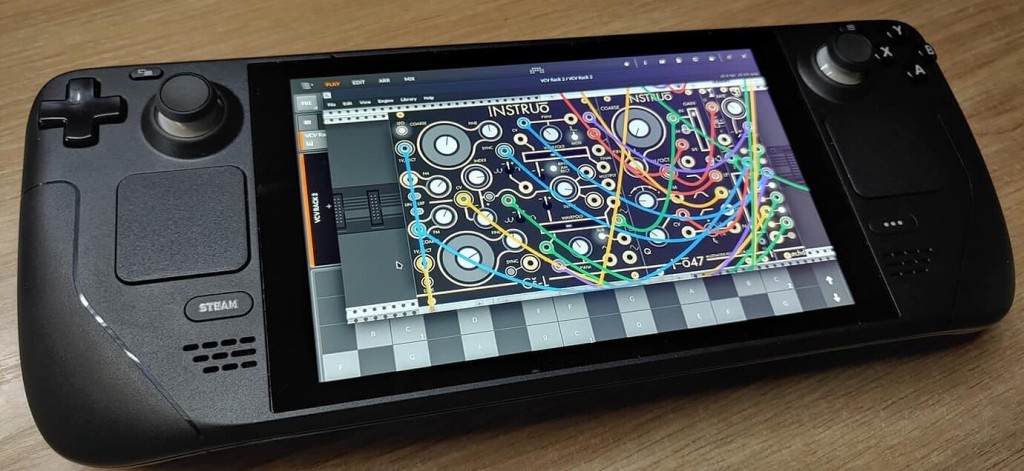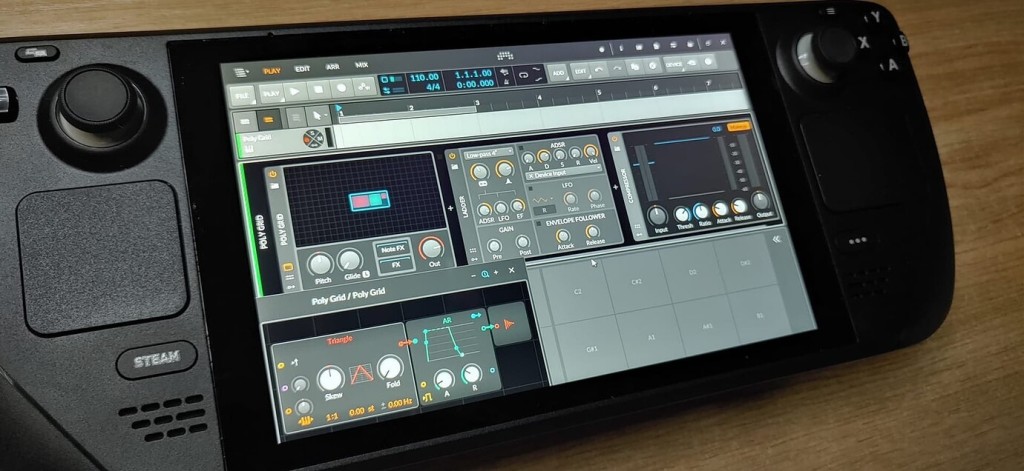It’s a portable gaming machine – but unlike other such devices, the Steam Deck is also an open, handheld, Linux-powered computer. And you know what that means: it’s a synth and a DAW, too.
I caught Aroon Karvna who’s working with the system and started some early tests, after seeing these photos as teaser. Now, Valve’s Steam Deck is pretty deeply back-ordered, so I expect this is mostly hypothetical for even many of us who put in a preorder. But it could be a glimpse of what’s to come. And after devices like Native Instruments’ Maschine+ adopted Linux, it’s also an indication that solutions could come from corners outside music tech makers.
Here’s what he’s running:

VCV Rack 2 Pro (as a plug-in)
PulseAudio sound system and minijack out (though JACK and ALSA show up and I can’t see any reason they shouldn’t also work – Mac/PC users, this is roughly equivalent to selecting Core Audio, DirectSound, ASIO, WASAPI…)

Let’s back up and explain what the Steam Deck is architecturally. While it looks like a sort of beefed-up, PC-ish take on Nintendo Switch, under the hood its OS is closer to a PC. (For the record, Switch uses NVIDIA Tegra X1/X1+ system on a chip; it’s the Nintendo system software that creates a closed environment. Valve uses an AMD SOC built by Quanta Computer.)
The OS is the key:
SteamOS is derived from the familiar Arch Linux distro.
KDE Plasma is the desktop GUI.
Your games are not all Linux-native, so Valve also uses a customized Wine compatibility layer, which they call Proton.
For audio purposes, this means you can definitely run your Linux-native software, and possibly even run some Windows VST plug-ins.
It gets better – you can even look through the included Discover app to find “flatpaks” for native apps, a bit like browsing app stores on other platforms. It sounds as though you need those flatpaks and not the normal arch installation, but I haven’t dug into those details yet as I don’t have a Steam Deck here. Ars Technica did a nice writeup for the Linux-ish folks out there:
A brief tour of the Steam Deck’s Linux implementation
What’s nice to hear from Aroon is that you can grab Bitwig Studio with that flatpak install, directly from Discover! (This is another advantage to software that lets you install directly, then license separately, rather than invoke a #(*$&($ companion app and… sorry, that’ll be a rant for another story.)
VCV Rack is installable without the flatpak. (VCV distributes their software as binary and then grabs modules via online connection.) Aroon writes, “VCV doesn’t offer a flatpak, but it’s just as easy – go to the VCV site, download the Linux version of the program, then follow the instructions to place folders in certain directories on your machine.”
Proton, for its part, opens up a lot of Windows compatibility. Wine itself has been improving, and Valve have done still more here – so Aroon tells us they haven’t even been that tempted to dual-boot to Windows yet.
Oh yeah, and games – everything from System Shock 2 to the much-newer Control are working swimmingly.
So, sure, Epic and Bandcamp may be teaming up, but I’ll be curious if artists releasing for this platform or even music software makers may soon be considering “Verified” ratings for music tools. That’d be a switch. Erm, sorry.
Watch this space.
Thanks to Aroon for the hands-on – check out their music as Polygloss – https://polygloss.bandcamp.com/
Now who else is also curious about this as a visual machine? Thought so…